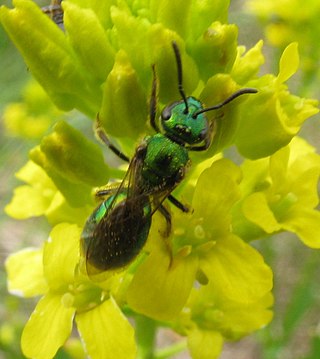Crabro cingulatus is a species of square-headed wasp in the family Crabronidae. It is found in Central America and North America.
Lasioglossum petrellum is a species of sweat bee in the family Halictidae.
Conanthalictus bakeri is a species of sweat bee in the family Halictidae. It is found in North America.
Andrena perarmata, the armed miner bee, is a species of miner bee in the family Andrenidae. Another common name for this species is the well-armed andrena. It is found in North America.

Colletes thoracicus, the rufous-chested cellophane bee, is a species of cellophane or plasterer, masked, or fork-tongued bee in the family Colletidae. It is found in North America.

Lithurgopsis apicalis, the orange-tipped woodborer, is a species of woodborer bee in the family Megachilidae. Adults commonly visit flowers of Cactaceae, Malvaceae, and Asteraceae, with nests built in stalks of Agave.
Habropoda pallida, known generally as the pallid habropoda or white-faced bee, is a species of anthophorine bee in the family Apidae. It is found in Central America and North America.

Tromatobia ovivora is a species of ichneumon wasp in the family Ichneumonidae.

Tromatobia is a genus of ichneumon wasps in the family Ichneumonidae. There are at least 4 described species in Tromatobia.

Kokkocynips imbricariae, the banded bullet gall wasp, is a species of gall wasp in the family Cynipidae.

Dufourea is a genus of sweat bees in the family Halictidae. There are at least 160 described species in Dufourea.

Augochlorella is a genus in the bee family Halictidae, commonly called sweat bees. They display metallic coloration, ranging from reddish to gold to bluish green, as is typical for other genera in the tribe Augochlorini.
The cherry leaf miner bee is a species of miner bee in the family Andrenidae. Another common name for this species is cherry plum miner. It is found in Central America and North America.

Stelis is a genus of kleptoparasitic cuckoo bees in the family Megachilidae. There are at least 100 described species in Stelis.
Stizoides foxi, or Fox's stizoide, is a species of sand wasp in the family Crabronidae. It is found in Central America and North America.

Ectemnius lapidarius is a species of square-headed wasp in the family Crabronidae. It is found in Africa, Europe and Northern Asia, North America, and Southern Asia.
Tachytes intermedius is a species of square-headed wasp in the family Crabronidae. It is found in Central America and North America.
Sphecodes mandibularis is a species of sweat bee in the family Halictidae.
Perdita rivalis is a species of mining bee in the family Andrenidae. It is found in North America.

Agathis is a genus of braconid parasitoid wasps. This genus was established by Latreille in 1804, and the type species is Agathis malvacearum Latreille, 1805. There are at least forty six species of Agathis in the western palearctic region.









